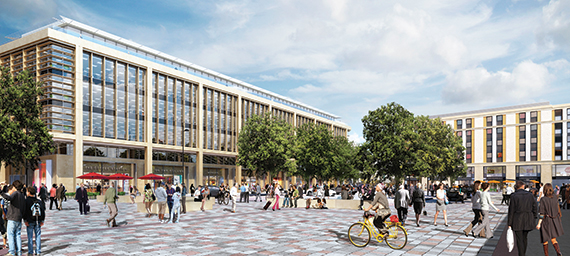 They call it the Cambridge phenomenon. It’s the ability of a city of just 125,000 people on the edge of the Fens to attract some of the world’s most exciting technology companies – Microsoft, Apple, Spotify and the rest.
They call it the Cambridge phenomenon. It’s the ability of a city of just 125,000 people on the edge of the Fens to attract some of the world’s most exciting technology companies – Microsoft, Apple, Spotify and the rest.
The attraction is, of course, obvious. Cambridge is home to one of the world’s greatest universities, attracts brilliant students who graduate and provide fantastic potential as employees and has a reputation for leading the way in technology and bioscience.
The Tech Nation 2016 report from Tech City UK, which focuses on the strength of the country’s digital cluster centres – tech hotspots, in other words – showed that Cambridge now employs 18,532 people in the digital sector and revealed a 46% hike in new digital companies incorporated in the city between 2010 and 2013.
Digital sector gross value added growth was up by 12% in the city over the period 2010-2014 and the turnover of firms in that sector was up by 46% over the same period.
These impressive stats go a long way to explain research from accountancy firm EY at the end of last year suggesting that Cambridge will be one of the fastest-growing economies in the UK over the next three years.
The city’s GVA will increase by 2.5% a year against a national average of 2.3% (December figures), says EY.
Stuart Wilkinson, partner at EY in Cambridge, says: “This growth is being fuelled by the region’s strengths in the UK’s rapidly expanding sectors – professional services, information and communications and real estate – reflecting the city’s strengths in knowledge and research-based sectors, including advanced electronics and pharmaceuticals.
“The university is what historically attracted all the tech companies. Then it was a snowball effect that saw great networks built that are attractive to companies coming in.
“Businesses in information technology, professional services and real estate then follow.”
But is there a danger of Cambridge becoming a victim of its own success? The “full up” signs aren’t being prepared yet but there are some concerns.
“I wouldn’t say the bubble is bursting but there are headwinds in respect of skills shortages and infrastructure,” says Wilkinson. “People need to be aware of it but there is no panic around it.”
He adds: “And organisations such as the East Anglia Combined Authority are looking into this and hopefully can do something about it.”
As for the commercial property sector, Wilkinson describes high demand in such a constricted market as “a challenge”.
Certainly, trying to find a home for would-be inward investors in a crowded historic city centre and on already crowded business parks is no mean feat.
Record take-up levels in 2015 have left little available space and put pressure on the labour market.
Chris Goldsmith, managing director of Cambridge-based developer Turnstone Estates, says: “I sense we are starting to get towards some sort of glass ceiling. Rents have risen very quickly and this is coupled with the high cost of staff.
“It is a fantastic market, let us not forget that, but there is limited supply. We need a dose of realism now and again about what the place is.”
That limited supply of oven-ready space means larger deals tend to be of a built-to-order variety. Three 75,000 sq ft- plus office and laboratory deals were signed off last year – referred to locally as “super-deals”.
These contributed to record office and lab market take-up last year of 1.1m sq ft, compared with the 956,000 sq ft achieved in 2014, according to research by Carter Jonas.
But now space in grade-A schemes in the centre of town and on the best business parks is at a premium, with £36.50 per sq ft being reached recently at Brookgate’s 130,000 sq ft One the Square building, in the city centre. Meanwhile, agents predict rents of £37 per sq ft will be achieved before the end of the year.
Just one year ago prime rents hovered around £32.50 per sq ft. A mixture of
high demand and lack of supply is the reason for rents heading north and explains why developer Brookgate is now seeking funding for another grade-A office development in CB1 – the 156,000 sq ft 50 & 60 Station Road, which will be built speculatively.
Many in the market believe the trigger for this recent surge in demand was the announcement in 2013 by AstraZeneca that the pharmaceuticals giant was moving from Cheshire to a new £330m global R&D headquarters in the city.
Will Heigham, Bidwells’s Cambridge head of office business space, says: “AstraZeneca has been a big catalyst for the market to accelerate. It has added gravitas. I think the supply chain will come in for the likes of AstraZeneca. We haven’t seen that yet.”
But the schemes that are coming forward aren’t all trying to attract super-deals.
At Cambridge Science Park, for example, the 40,000 sq ft Sir John Bradfield Centre is being built as an innovation hub for nascent businesses. But larger occupiers seeking to move may choose to keep their powder dry.
Will Mooney, partner and head of the eastern region commercial division at Carter Jonas, says: “It’s going to be an interesting year for occupiers.
“Inflated rents could put pressure on moving. People may consolidate or move out further.”
Steve Lang, a director in the research team in Savills, suggests that overspill could boost nearby towns.
“The likes of Hawkenbury and Huntingdon could benefit from offering overflow space at a lower price,” he says.
But Turnstone Estates’ Goldsmith is not so sure. “It’s not an absolute but generally if people want to be in Cambridge they want to be in Cambridge,” he says.

Elsewhere in the East of England
According to the EY UK Region and City Economic Forecast, the East of England’s economy as a whole is predicted to grow by 2.5% in GVA terms between 2015 and 2018.
Norwich, traditionally strong in financial services and more recently med-tech, is starting to benefit from road improvements.
The completion of the long-awaited dualling of the A11 has improved links to the city and could promote investment in the area. Likewise, work on the Norwich Northern Distributor Road, set to start in the summer, will improve access to Norwich Airport.
It may surprise some to know that Norwich is ranked fourth in the UK for the number of scientists based there – after London, Cambridge and Oxford. And the city hopes to base its growth on business associated with the science sector (see City Talk, page 100).
Ipswich, meanwhile, is enjoying something of a growth spurt, especially in the private sector.
Centre for Cities research reveals that 2,700 private sector jobs were created in Ipswich in 2014, helping to make it a top 10 city for private sector jobs growth.
As a result, it has seen a significant increase in take-up, hitting circa 160,000 sq ft during 2015, a marked increase on the five-year average of 80,000 to 90,000 sq ft.
Meanwhile, Peterborough is well advanced in its plans to transform itself into a “gigabit city” to attract businesses requiring superfast broadband.
However, it is suffering from a lack of office stock, partly as a result of buildings converting to residential use following the arrival of permitted development rights. Prime rents have gone up as a result.











